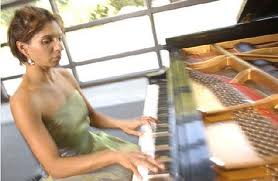|
Symphony
FROM THE NEW WORLD TO THE OLD WORLD
by Peter Lert
Saturday, June 14, 2025
Chamber
MC2 DUO RECITAL CLOSES 222'S SEASON
by Terry McNeill
Saturday, June 14, 2025
Choral and Vocal
CANTIAMO SONOMA'S LUSCIOUS A CAPELLA SINGING IN SEASON ENDING CONCERT
by Pamela Hicks Gailey
Sunday, June 8, 2025
Symphony
SRS SEASON ENDS WITH RESOUNDING TA-TA-TA-BANG
by Terry McNeill
Sunday, June 1, 2025
Symphony
YOUTHFUL VIRTUOSITY ON DISPLAY AT USO'S MAY CONCERTS
by Peter Lert
Saturday, May 17, 2025
Symphony
MYSTICAL PLANETS AND LIVELY GERSHWIN ORTIZ AT FINAL SRS CONCERT
by Peter Lert
Sunday, May 4, 2025
Symphony
VSO'S CONCERT MUSIC OF TIME, MUSIC OF PLACE
by Peter Lert
Sunday, April 27, 2025
VOCAL ELEGANCE AND FIRE AT THE 222'S RECITAL APRIL 26
by Pamela Hicks Gailey
Saturday, April 26, 2025
CANTIAMO SONOMA SINGS AN INSPIRED GOOD FRIDAY MOZART REQUIEM CONCERT
by Pamela Hicks Gailey
Friday, April 18, 2025
DRAMATIC SHOSTAKOVICH SYMPHONY CLOSES PHILHARMONIC'S 25TH SEASON
by Terry McNeill
Sunday, April 13, 2025
|
 |
 Pianist Lara Downes |
AMERICAN MUSIC FEATURED IN DOWNES' CINNABAR RECITAL
by Terry McNeill
Wednesday, September 8, 2010
Pianist Lara Downes is a proselytizer, a woman on a mission to spread the gospel of American classical music of the early 20th century. Ms. Downes brought her musical discourse to Petaluma’s Historical Museum Sept. 8 in the penultimate concert of Cinnabar Theater’s Summer Music Festival.
Beginning with the popular Barber Excursions, Op. 20, from 1944, the pianist quickly fashioned was to come in the evening’s additional works – large-screen computer generated photos mixed with piano solos and deft introductory remarks. The Walker Evans-style photos didn’t always relate to the music at hand, and tended to be on the screen too long. The rhythmic drive of the opening un poco allegro had the alluring boogie woogie snap, as did the following syncopations of the slow blues. The fourth work, a square dance, was Coplandesque and the repeated right hand notes were well played. These are not subtle pieces with much tonal coloring, and needed the clangorous sound Ms. Downes provided.
Turning to Copland himself, the “Four Piano Blues” followed. This is sophisticated jazz, totally American, and the improvisatory first piece was freely poetic and featured telling pedal points. Less compelling pianistically was a languid and wandering reading of the second piece, but with lovely shimmering effects. Ms. Downes’ sensuous repeated arpeggios barely covered the inherent dissonances of the third, and the jazziest of the set (“With Bounce,” 1926) was a declamatory short dance, and riveting.
Florence Price’s music, with that of Margaret Bonds, is occasionally heard at festivals, and it was good to find Price’s “Fantasie Negre” on the program. A student of Chadwick, Converse and Sowerby, Price wrote the neo-romantic work (a revision from a concerted piece?) that had the long line, with a beguiling second section in a “question and answer” mode and a diffuse sound, often over pedaled by the pianist. But it’s that kind of work, far removed from the harmonies of the composer’s contemporaries. Ms. Downes reveled in the sweep of the Fantasie with the sound filling every corner of the wood-surfaced museum.
Two more works remained, the American Nocturne by the jazz and Broadway composer Dana Suesse (1909 – 1987), the Gershwin’s big “Rhapsody in Blue” in the solo piano version. The first is cocktail party music, but at a high level, and the second is a panoramic compilation of the American master’s richly-hued jazz themes. I do miss the clarinet’s trill/glissando in the original version but the energy Ms. Downes brought to the work finally won me over. Pianistically the scales passes were even but muddy and the lack of sections of real repose and ritards combined with full-throttle forte and rapid tempo playing became overly sonorous. The approach worked best at the beginning of the big modulatory sections where orchestral playing is needed.
The Gershwin is familiar territory and the vigor the pianist pursued brought loud cheers from the audience of 40. One encore was offered, a short Copland piece in a dreamy style, the cantabile captivating. It was the only work the artist played from score.
|
